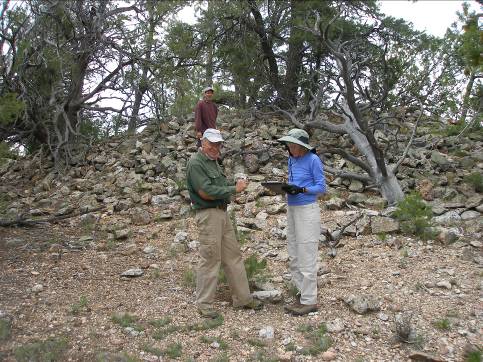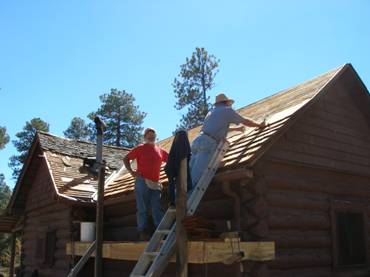Cohonina Migration 2006 - Passport in Time
Main menu:
Previous Projects > States A-F
Investigating Cohonina Migration in the Upper Basin
Kaibab National Forest, Arizona, 2006
by Neil S. Weintraub, South Kaibab Zone Archeologist
Between September 17 and September 22, 2006, the Kaibab National Forest Heritage Resources program hosted its 17th PIT project south of the Grand Canyon. Fourteen volunteers contributed 700 hours towards conducting in-field ceramic analysis to study evidence of 12th Century Cohonina migration into this area, as well as re-roofing Hull Cabin, the Grand Canyon area’s oldest standing cabin dating to 1888, with fire-proof shingles.
Investigating Cohonina Migration
Since 1999, Kaibab National Forest archaeologists have discovered that the prehistoric use of the Grand Canyon south rim area did not end during the Late Pueblo II period. As a result of three large-scale PIT projects, archaeologists have clearly demonstrated evidence for a strong Pueblo III presence along the Coconino Rim and in the Upper Basin on the Tusayan Ranger District. More recently, Kaibab archaeologists have also discovered that Cohonina populations likely migrated from the Coconino Plateau shortly before AD 1100. Kaibab archaeologists have postulated that the Cohonina, who produced ubiquitous Deadmans Gray pottery, migrated from the Coconino Plateau in at least three directions: east into Deadmans Wash and the previously sparsely populated Wupatki area, south into the Sycamore Basin, and north into the Upper Basin, east of Grand Canyon’s south rim.
Prior to a.d.1100, the Wupatki area appears to have had sparse populations, whereas the Kayenta Anasazi were well established in the Upper Basin. Jeanne Stevens-Schofer’s 2006 Master’s thesis provides strong support that the Cohonina were the first puebloan culture to have habitation structures in the Wupatki Basin around a.d. 1130.
To study Cohonina migration into the Upper Basin, archaeologists decided to test archeologist Dan Sorrell’s hypothesis which proposed that Deadmans Gray pottery gets thicker between a.d. 700 and a.d. 1150. If Dan’s hypothesis is valid, then the average sherd thickness of Deadmans Gray on post a.d. 1100 sites in the Upper Basin could indicate that even after the Cohonina abandoned the Coconino Plateau (their heartland), they continued producing their pottery. This has important implications for assessing our migration theory. This finding also may help us better date sites in the Cohonina heartland that only have Deadmans Gray sherds. Of the 4000 ceramic bearing sites in the Cohonina Heartland, only 1900 of them are dated based on well-dated trade wares. Of these 4000 sites, only a handful date to the Pueblo III period, thus suggesting to us that Cohonina largely moved away from the area shortly after the eruption of Sunset Crater - ca a.d. 1070.
Mean Ceramic Dating and Analysis Methods
As a control for this study, archaeologists also used Dr. Chris Downum’s mean ceramic dating spreadsheet to establish a time frame for the sites in the Upper Basin. As a result, archaeologists needed to collect two sets of data. First, for Sorrell’s Deadmans Gray thickness study, archaeologists needed to analyze 50 Deadmans Gray sherds by taking 5 measurements from 4 corners and the center of the sherd to come up with a statistically valid average thickness. For Downum’s study, archaeologists and volunteers needed to systematically pin flag all sherds, and analyze them with type counts. Archaeologists then decided (especially on the Pueblo III period hilltop structures which had fewer artifacts than the pueblos) to pin flag Deadmans Gray sherds until all 50 flags were used. Once they reached 50, no more sherds could be flagged. In this manner we believed that we were not biasing data collection towards any ceramic type. If fewer Deadmans Gray sherds were represented, then it would take longer to flag 50 and there would be a higher percentage of other ceramics. Conversely, if Deadmans were more common, then the assemblage would have a smaller representation of non-Deadmans Gray sherds. On sites with thousands of artifacts, archaeologists divided the site into halves or quadrants to compare results.
 (Photo: PIT Volunteers Bill Nightwine, Pam Kalish and Larry Offenberg. Notice the large rubble mound that is typical of Pueblo III period structures on the Coconino Rim.)
(Photo: PIT Volunteers Bill Nightwine, Pam Kalish and Larry Offenberg. Notice the large rubble mound that is typical of Pueblo III period structures on the Coconino Rim.)It should be noted that several volunteers questioned the statistical methods of this study. To test the error that two different archeologists might obtain, Weintraub had archeologist Elizabeth Lane re-examine his analysis of Site 0307040005, the latest site in the project area, which Weintraub’s mean ceramic dated to a.d. 1171. Weintraub determined a Deadmans Gray average sherd thickness of 5.74 mm on the site. He did not allow Lane to know his results. When Lane conducted her analysis, she dated the site to a.d. 1172 and determined the Deadmans Gray to be even thicker at 5.88 mm.
At the end of the project, Weintraub immediately sent Dan Sorrell the Deadmans Gray thickness values and the results are listed in Table 1.
Ceramic Analysis from Sites Along the Coconino Rim
| Site No | Initial Site Recording | DMG Thickness (mm) | Sorrell Linear Regression Date | Sorrell Quadratic Equation Date | Downum Mean Ceramic Date |
| 0307040005 | Pueblo III | 5.74 | AD 1209 | AD 1148 | AD 1172 |
0307040006 | Pueblo III | 5.54 | AD 1161 | AD 1139 | AD 1142 |
03070401365 | Pueblo III | 5.76 | AD 1214 | AD 1149 | AD 1181 |
03070401384 | Pueblo II | 5.14 | AD 1064 | AD 1081 | AD 1069 |
03070401405 | Pueblo II | 5.24 | AD 1088 | AD 1099 | AD 1034 |
03070401406 | Pueblo II | 5.25 | AD 1091 | AD 1099 | AD 1107 |
Table 1: This table represents results of the first blind study done on the results from sites along the Coconino Rim. Weintraub sent Sorrell only the Deadmans Gray thickness values without discussing the Mean Ceramic Date. According to Sorrell, the quadratic equation works the best.
By the end of the project, archaeologists and volunteers analyzed ceramics from 15 sites ranging in dates from a.d. 900 to a.d. 1200, or the Pueblo II to the Pueblo III period. While there are still data to analyze, preliminary indications from sites along the Coconino Rim strongly suggest that the Cohonina were still producing Deadmans Gray into the Pueblo III period, and thus co-existing with their Kayenta Anasazi neighbors in the Upper Basin, rather than living on the lands they had formerly occupied to the south. This finding, however, raises new questions. Does this pattern hold in the Sycamore Basin area south of Williams where similar hilltop forts occur at the same time period? Are the Cohonina still living on the Coconino Plateau or just returning to get clay for their pottery? Does Deadmans Gray pottery get thicker in Wupatki National Monument? All these we questions and more are ones that we hope future PIT projects will help us explore!
Hull Cabin Fire-Proof Shingle Project.
 Another important component to the 2006 PIT project was to begin rehabilitating Hull Cabin so that it can enter the Cabin Rental program within the next two years. Kaibab Historic Cabins stabilization specialist John Azar undertook this project at the last second and worked with PIT volunteer Brad Heap to put fireproof shingles on the Cabin. First built by the Hull Brothers in 1888, Hull is the oldest standing cabin in the Grand Canyon area. The Forest Service last maintained this structure in 1989. During the week, Azar and Heap re-shingled approximately two-thirds of the roof with completion expected by mid-October.
Another important component to the 2006 PIT project was to begin rehabilitating Hull Cabin so that it can enter the Cabin Rental program within the next two years. Kaibab Historic Cabins stabilization specialist John Azar undertook this project at the last second and worked with PIT volunteer Brad Heap to put fireproof shingles on the Cabin. First built by the Hull Brothers in 1888, Hull is the oldest standing cabin in the Grand Canyon area. The Forest Service last maintained this structure in 1989. During the week, Azar and Heap re-shingled approximately two-thirds of the roof with completion expected by mid-October.(Photo: John Azar and Brad Heap work on fireproofing Hull Cabin roof.)
Without the research conducted by PIT volunteers, archaeologists could never have found the time outside their normal Section 106 duties to collect data and process a study of this scale.